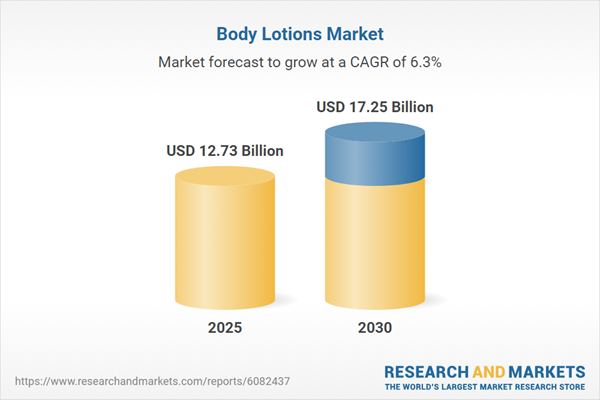Speak directly to the analyst to clarify any post sales queries you may have.
The global body lotions market is evolving in response to consumer demand for transparency, personalized skincare, and environmentally responsible products, creating complex opportunities for strategic growth and innovation across supply chains and channels.
Market Snapshot: Body Lotions Market Analysis
The body lotions market grew from USD 11.97 billion in 2024 to USD 12.73 billion in 2025. It is forecast to expand at a 6.43% CAGR, reaching USD 19.72 billion by 2032. This steady upward trajectory reflects how brands are navigating dynamic shifts in consumer wellness priorities, heightened demand for sustainable options, and technological advancements that reshape both product development and distribution. Senior decision-makers must recognize these driving factors as they redefine the market’s competitive landscape.
Scope & Segmentation
This report delivers comprehensive analysis across a range of market dimensions to ensure relevance for strategic planning and investment decisions:
- Distribution Channels: Brick-and-mortar such as convenience stores, pharmacy drugstores, specialty stores, supermarket hypermarkets; a diverse online ecosystem including brand websites, e-commerce platforms, and social commerce; and specialty retailers.
- Product Types: Body creams, body lotions, gel lotions, and spray lotions.
- Skin Types: Dry, normal, oily, and sensitive formulations engineered for specific consumer concerns.
- End Users: Kids, men, women, and unisex consumers, with segments shaped by age, lifestyle, and gender factors.
- Price Range: Economy, mid-range, premium, and luxury tiers emphasizing value, aspiration, or exclusive experiences for different audiences.
- Formulations: Conventional and organic formulations designed to address both performance and the growing appeal of natural ingredients.
- Application Sites: Full body, hands, and feet-specific products tailored for optimal efficacy.
- Regional Coverage: Comprehensive analysis of Americas (North America and Latin America), Europe, Middle East & Africa (including Western Europe, Middle East, and Africa), and Asia-Pacific (covering key economies across East, Southeast, and South Asia, as well as Oceania).
- Key Companies: Unilever PLC, L'Oréal S.A., Beiersdorf AG, Johnson & Johnson, The Procter & Gamble Company, The Estée Lauder Companies Inc., Shiseido Company, Limited, Kao Corporation, Amorepacific Corporation, Colgate-Palmolive Company.
Key Takeaways for Senior Leaders
- Digitally enabled sales models drive new avenues for direct consumer engagement, with social and e-commerce channels gaining market share against traditional retail.
- Personalization and advanced diagnostics, including the use of AI, are accelerating the shift toward tailored skincare, increasing loyalty and premiumization potential.
- Brands are optimizing portfolios by leveraging collaborations with biotech partners to enhance efficacy, sustainability, and transparency within formulations and product delivery systems.
- Shift in supply chain strategies toward regional partnerships and nearshoring assists in mitigating risks related to global logistic disruptions and trade complexities.
- Segmented product offerings aligned to local cultural preferences and regulatory environments are expanding competitive opportunities regionally, especially in Asia-Pacific and EMEA.
- Packaging innovation—such as recyclable and refillable solutions—is now a major point of differentiation, reflecting evolving consumer attitudes and regulatory pressures.
Tariff Impact: Navigating 2025 U.S. Trade Measures
With new 2025 U.S. tariff policies, supply chain complexity rises for body lotion manufacturers. Heightened import costs on key ingredients and packaging have prompted companies to reassess sourcing, emphasizing regional suppliers and long-term relationship building. Some participants are realigning procurement models to prioritize cost-control and agility, while others turn to nearshoring or domestic sourcing to offset logistical challenges and maintain brand margins without sacrificing quality or responsiveness.
Methodology & Data Sources
This report is grounded in a rigorous, multi-stage research process, starting with secondary research and analysis of regulatory documents, industry reports, and journals. Extensive primary interviews with stakeholders across the value chain informed trend mapping, with all quantitative findings triangulated to ensure consistency and validity. Final insights underwent iterative review for accuracy and actionable value.
Why This Report Matters
- Informs executive decision-making by identifying actionable trends, supply chain adjustments, and growth opportunities within the evolving global skincare landscape.
- Equips strategy, innovation, and procurement leaders with in-depth insights across product, channel, and regional segments for precise market positioning.
- Supports risk management and resource allocation by providing analysis on trade disruptions and regulatory shifts impacting sourcing and competitive strategy.
Conclusion
The body lotions market is accelerating through innovation, segmentation, and sustainability. Leaders who embrace adaptive strategies informed by research will be well positioned to capture value in this complex, evolving sector.
Table of Contents
3. Executive Summary
4. Market Overview
7. Cumulative Impact of Artificial Intelligence 2025
Companies Mentioned
The companies profiled in this Body Lotions market report include:- Unilever PLC
- L'Oréal S.A.
- Beiersdorf AG
- Johnson & Johnson
- The Procter & Gamble Company
- The Estée Lauder Companies Inc.
- Shiseido Company, Limited
- Kao Corporation
- Amorepacific Corporation
- Colgate-Palmolive Company
Table Information
| Report Attribute | Details |
|---|---|
| No. of Pages | 186 |
| Published | October 2025 |
| Forecast Period | 2025 - 2032 |
| Estimated Market Value ( USD | $ 12.73 Billion |
| Forecasted Market Value ( USD | $ 19.72 Billion |
| Compound Annual Growth Rate | 6.4% |
| Regions Covered | Global |
| No. of Companies Mentioned | 11 |









